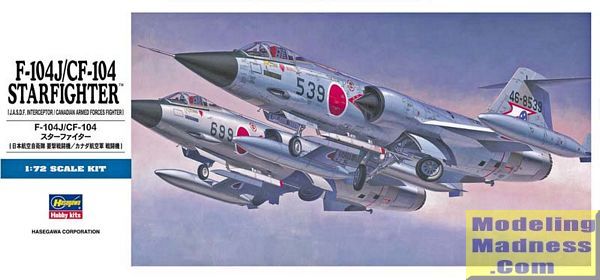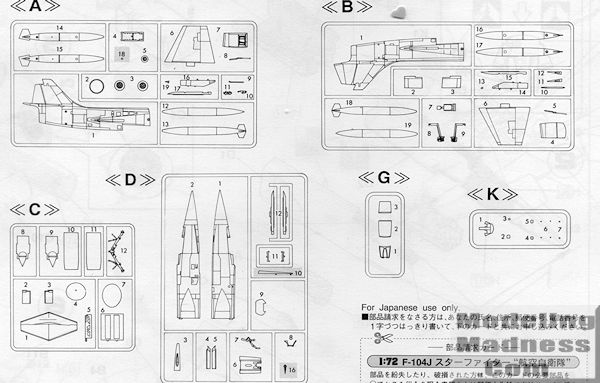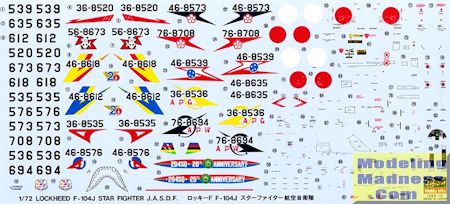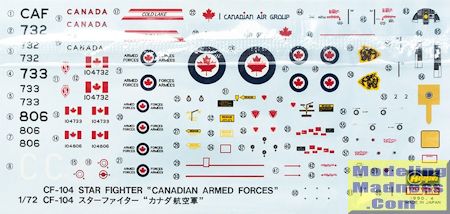
Hasegawa 1/72 F-104J/CF-104 Starfighter
| KIT #: | 00446 |
| PRICE: | @20.00 SRP |
| DECALS: | 15 options |
| REVIEWER: | Scott Van Aken |
| NOTES: | Current base boxing 1999 |

| HISTORY |
The Lockheed F-104 Starfighter is a single-engine, supersonic interceptor aircraft originally developed by Lockheed for the United States Air Force (USAF). One of the Century Series of aircraft, it was operated by the air forces of more than a dozen nations from 1958 to 2004. Its design team was led by the same man who later went on to design the SR-71 Blackbird, Kelly Johnson
The F-104 served with the USAF from 1958 until 1969, and continued with Air National Guard units until 1975. The National Aeronautics and Space Administration (NASA) flew a small mixed fleet of F-104 types in supersonic flight tests and spaceflight programs until 1994.[3] USAF F-104Cs saw service during the Vietnam War, and F-104A aircraft were deployed by Pakistan briefly during the Indo-Pakistani wars. Republic of China Air Force (Taiwan) F-104s also engaged the People's Liberation Army Air Force (China) over the disputed island of Quemoy. The operational service of the Starfighter ended with its retirement by the Italian Air Force in May 2004.
A total of 2,578 Starfighters were produced, mostly by NATO members and Japan. A set of modifications produced the F-104G model, which won a NATO competition for a new fighter-bomber. Several two-seat trainer versions were also produced, the most numerous being the TF-104G. The ultimate production version of the fighter model was the F-104S, an all-weather interceptor designed by Aeritalia for the Italian Air Force, which was equipped with radar-guided AIM-7 Sparrow missiles. An advanced F-104 with a high-mounted wing, known as the CL-1200 Lancer, did not proceed past the mock-up stage.
The poor safety record of the Starfighter brought the aircraft into the public eye, especially in German Air Force service. Fighter ace Erich Hartmann famously was retired from the Luftwaffe because of his protests against having to deploy the unsafe F-104s. (In defense of the F-104, the Luftwaffe up until that time, was a 'country club' air force that was used to flying rather docile F-84 and F-86 aircraft. The F-104 took quite a bit more attention to fly and was not as forgiving of mistakes) The F-104 was also at the center of the Lockheed bribery scandals, in which Lockheed had given bribes to a considerable number of political and military figures in various nations in order to influence their judgment and secure several purchase contracts; this caused considerable political controversy in Europe and Japan.
| THE KIT |
 Hasegawa decided on a new tooling to replace their early and rather basic F-104 kit in the 1990s and this was the result. It is a thoroughly modern molding with engraved panel lines, the usual ability to be kitted in several different versions (hence the separate nose section), and with enough detail to please most.
Hasegawa decided on a new tooling to replace their early and rather basic F-104 kit in the 1990s and this was the result. It is a thoroughly modern molding with engraved panel lines, the usual ability to be kitted in several different versions (hence the separate nose section), and with enough detail to please most.
Typical of all Hasegawa 1/72 kits, the cockpit has instruments represented by decals and could also use an aftermarket seat, though the one provided has the proper shape. An interesting item is that the cockpit tub can have the sidewalls moved to properly fit the instrument panel. This cockpit fits atop a one-piece nose gear well. One builds up the nose section before attaching it to the completed fuselage section late in the build. This is to allow the TF-104 to be kitted using many of the same parts. There is a nicely done tail pipe that has an exhaust compressor stage visible. This is not the case for the intakes which simply disappear into the fuselage. Thanks to the design of the intakes, you will not notice any issues with this.
Landing gear are nicely done and quite well detailed. The forward main gear doors are shown in their proper 'near closed' condition. The wings are a single piece as is appropriate for such thin constructs and holes for the pylons are already opened up in the bottom of them to accept the wing pylons. There are fuel tanks for these pylons as well as either wing tip missile pylons or fuel tanks. There are also lower fuselage missile pylons provided, but no armament is included, that having to come from the various Hasegawa weapons sets. The cockpit canopy can be displayed open or closed.
weapons sets. The cockpit canopy can be displayed open or closed.
Instructions are well done and provide the usual Gunze paint references as well as any modifications needed. Hasegawa provides two full sets of instructions depending on whether you want to model the CF-104 or the F-104J. You get a whopping 15 markings options. For the CF-104 you can model one of three camo schemes; one unpainted metal, one overall green and one in a green/grey camouflage scheme. For the F-104J you have options for any of the units that flew the plane and it includes a two grey camouflaged plane from the last unit to fly the plane, 207 Squadron. The Japanese decal sheet fills the bottom of the box. Though the instructions show all the planes in overall light grey with metal exhaust areas, these planes were also flown in unpainted metal, though you really should locate a photo for that purpose. Despite their age, the decals look quite usable, though the whites are a more of an off-white.
one unpainted metal, one overall green and one in a green/grey camouflage scheme. For the F-104J you have options for any of the units that flew the plane and it includes a two grey camouflaged plane from the last unit to fly the plane, 207 Squadron. The Japanese decal sheet fills the bottom of the box. Though the instructions show all the planes in overall light grey with metal exhaust areas, these planes were also flown in unpainted metal, though you really should locate a photo for that purpose. Despite their age, the decals look quite usable, though the whites are a more of an off-white.
| CONCLUSIONS |
I have only built this kit one time and that was an Italian version. I found the build to be quite pleasant as the parts fit well and things went together rather quickly. This is really a super kit and anyone with an interest in the type should locate one of the many boxings and give it a go.
| REFERENCES |
http://en.wikipedia.org/wiki/Lockheed_F-104_Starfighter
April 2015 Thanks to me for the preview kit. If you would like your product reviewed fairly and fairly quickly, please contact the editor or see other details in the